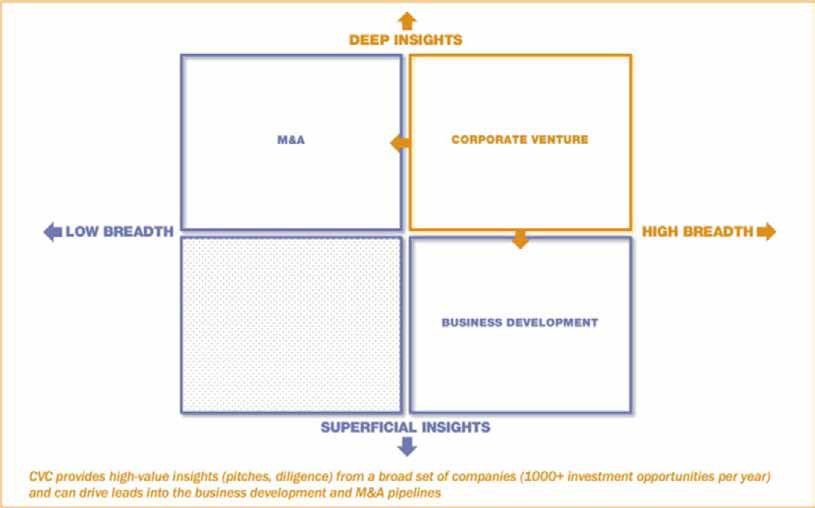Top global firms increasingly use corporate venture capital (CVC) as part of their innovation strategy. The corporate venturing market has expanded as deal sizes grow and new players seek investment in strategic technology. The competition benefits consumers who gain access to newer, innovative products, but it poses a significant challenge to firms that must find quality proprietary deals to fuel future growth.

Key Innovation Tool to Develop Value
Firms gain significant benefits from corporate venturing, so its growth as a strategy is almost predictable. Corporate venture capital supports firm innovation, drives up firm value, and provides management with tools to identify emerging trends in advanced technology. It's simply the latest evolution of firms' long-standing practice of open innovation.
A 2013 Boston College study on the connection between corporate venturing and firm innovation found that a CVC program that combines the features of R&D labs with venture-backed start-ups is a leading way to advance innovation. CVC-backed firms secure more patents than through independent venture capital, indicating higher productivity.
That productivity leads to higher firm value. The ROI is significant: For every $1 million investment in corporate venture capital, the average Tobin's Q (market value/assets) goes up by 0.20. By default, external forces are encouraging firms to implement corporate venturing strategies in order to bolster their market values.
Moreover, corporate venture groups are invaluable assets for gathering market intelligence. Their function is to analyze trends in funding and acquisition, thereby gaining insight into emerging industries and technologies. A firm's best in-house resource to find the technology of the future can be its CVC team.

Competition Makes Sourcing Deals More Difficult
Given these facts, the recent corporate venture capital market boom is no sur prise. That boom is not merely anecdotal; it's backed up by evidence that deals increased in number and size in 2015 and featured greater participation from non-American companies.
prise. That boom is not merely anecdotal; it's backed up by evidence that deals increased in number and size in 2015 and featured greater participation from non-American companies.
Global Corporate Venturing reported $75.3 billion in capital investments over 1,100 deals in 2015, an all-time high. Corporate venturing accounts for one-quarter of all venture capital deals. There has been a 150 percent growth since 2011. With this massive expansion, new corporate venture groups have come on the scene to take advantage of the burgeoning industry. In fact, 85 new CVC groups made their first investment in 2015.
The phenomenon is global, with countries such as China, Japan, Canada, India, and Germany all significantly increasing domestic corporate venture capital activity in recent years. These non-American groups have propelled the number of total active CVC units to 801, a 79 percent increase since 2011.
Consumers want innovation, and this increased competition leads to more products that meet that need. It is a challenge, however, for firms that must identify, evaluate and source technology. Firms that don't meet the challenge will lose market share, and they are tasked to implement corporate venturing strategies that keep them on the leading edge of innovation.
Moving Beyond Business as Usual
Over the past five years, corporate venturing has increasingly become a strategic tool for innovation. Research shows corporate venture capital is more effective than independent venture capital in driving innovation. External market forces mandate CVC investment to increase share value. As CVC becomes more important, more corporate venturing groups are entering the marketplace and competing for lucrative proprietary deals. Firms that proceed with business as usual will be left behind. Learn more about adopting the latest best practices on the recorded webcast hosted by Global Corporate Venturing.
Sources
"The Venture Capital Firm, Operations, and Culture." Insights from Leading Practitioners on the Art of Raising a Fund, Deal Structuring, Value Creation, and Exit Strategies The Business of Venture Capital (2014): 137-47.
Dushnitsky, Gary, and Michael J. Lenox. "When Does Corporate Venture Capital Investment Create Firm Value?" Journal of Business Venturing 21.6 (2006): 753-72.
KPMG and CB Insights. "Venture Pulse Q4 2015: Global Analysis of Venture Funding." (2016).
Global Corporate Venturing Analytics
Lewis, Toby, James Mawson, Claudia Fan Munce, Scott Lenet, Andrew Gaule, Frank Lampen, Tracy Isacke, Deborah Marshall, Marc Gottschaulk, Martin Haemmig, Boris Battistini, Chirag Patel, Paul Morris, and Heidi Mason. World of Corporate Venturing 2016. (2016).

